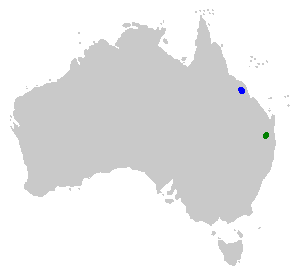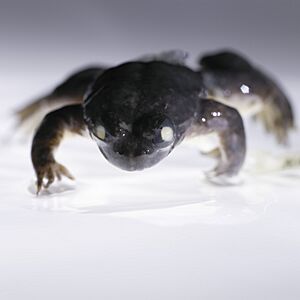Southern gastric-brooding frog facts for kids
Quick facts for kids Southern gastric-brooding frog |
|
|---|---|
 |
|
| A specimen of a southern gastric-brooding frog | |
| Conservation status | |
| Scientific classification | |
 |
|
| Distribution of the southern gastric-brooding frog (green) |
The Rheobatrachus silus, also known as the southern gastric-brooding frog, was a unique frog from Australia. It is now an extinct species. This means it has sadly disappeared forever. What made it special was how it raised its young. The mother frog would swallow her eggs and keep her babies safe inside her stomach until they were ready to hatch!
Contents
Where it Lived
Scientists first found the southern gastric-brooding frog in 1972. It lived only in a small part of southeast Queensland, north of Brisbane. This area included the Blackall Range and Conondale Range.
These frogs lived in places like rainforests and wet sclerophyll forests. They also lived near rivers. Their home was limited to a small area, less than 1,400 square kilometers (540 square miles). They were found in streams that flowed into the Mary, Stanley, and Mooloolah Rivers.
What it Looked Like
The southern gastric-brooding frog was a medium-sized frog. It had a dull gray or slate color. Its skin was moist and covered in mucus. It had large eyes that stuck out and were close together. Its snout, or nose, was short and blunt.
The frog's back had small patches that were darker or lighter than its main color. Its belly was white or cream, sometimes with yellow spots. Its arms and legs had dark brown stripes on top and were yellow underneath. A dark stripe ran from its eye to its front leg.
Its fingers were long and thin, without webs. Its toes, however, were fully webbed, which helped it swim. The frog's arms and legs were quite large compared to its body. Female frogs were bigger than males. Males were about 30 to 44 millimeters (1.2 to 1.7 inches) long. Females were larger, measuring 41 to 54 millimeters (1.6 to 2.1 inches) long.
How it Lived and Behaved
The southern gastric-brooding frog loved water. It lived mostly in streams and nearby rock pools. The streams where they lived usually flowed all year round. They only stopped flowing during very dry years.
During the day, these frogs often hid at the edge of rock pools. They would hide among leaf litter, under stones, or in rock cracks. They were also found under rocks in shallow water. In winter, they were rarely seen. Scientists think they might have hibernated during the colder months.
Adult male frogs preferred deeper pools. Young frogs and females liked shallower pools. These shallower pools often formed after rain and had stones or leaf litter. Frogs only sat out in the open on rocks when it was raining lightly.
The frog's diet included insects from both land and water. They were seen eating moths, flies, and lacewings in aquariums. The call of the southern gastric-brooding frog sounded like "eeeehm...eeeehm." It lasted about half a second and was repeated every 6 to 7 seconds.
These frogs did not move very far from water. They were never found more than 4 meters (13 feet) away from a stream or pool. Studies showed that most young frogs moved less than 3 meters (10 feet). Adult frogs also stayed in the same pools during breeding season. They only moved if there was a flood.
Why it Disappeared
The southern gastric-brooding frog's population started to drop after 1979. The last time anyone saw this frog in the wild was in 1981. The very last frog known to be alive, which was in captivity, died in 1983.
Scientists searched for the frog many times in the 1990s, but they could not find any. In 2000, the southern gastric-brooding frog was officially declared extinct. This means it is gone forever.
The exact reasons for its disappearance are not fully clear. However, scientists think several things might have caused it. These include changes to the land where they lived, new species moving into their habitat, and a deadly frog disease called chytridiomycosis.
Bringing it Back to Life?
Scientists are now trying to bring the gastric-brooding frog species back to life! This amazing project is called de-extinction. They are using a method called somatic-cell nuclear transfer, which is a way to clone animals.
In 2013, Australian scientists successfully created a living embryo from preserved genetic material. This was a huge step! These scientists hope to continue their work. Their goal is to create an embryo that can grow into a tadpole. One researcher, Mike Archer, said, "We do expect to get this guy hopping again."
Scientists have also successfully frozen and thawed frog embryonic cells. This shows that they can store the genetic information of threatened amphibians. This could help save other animals in the future.



